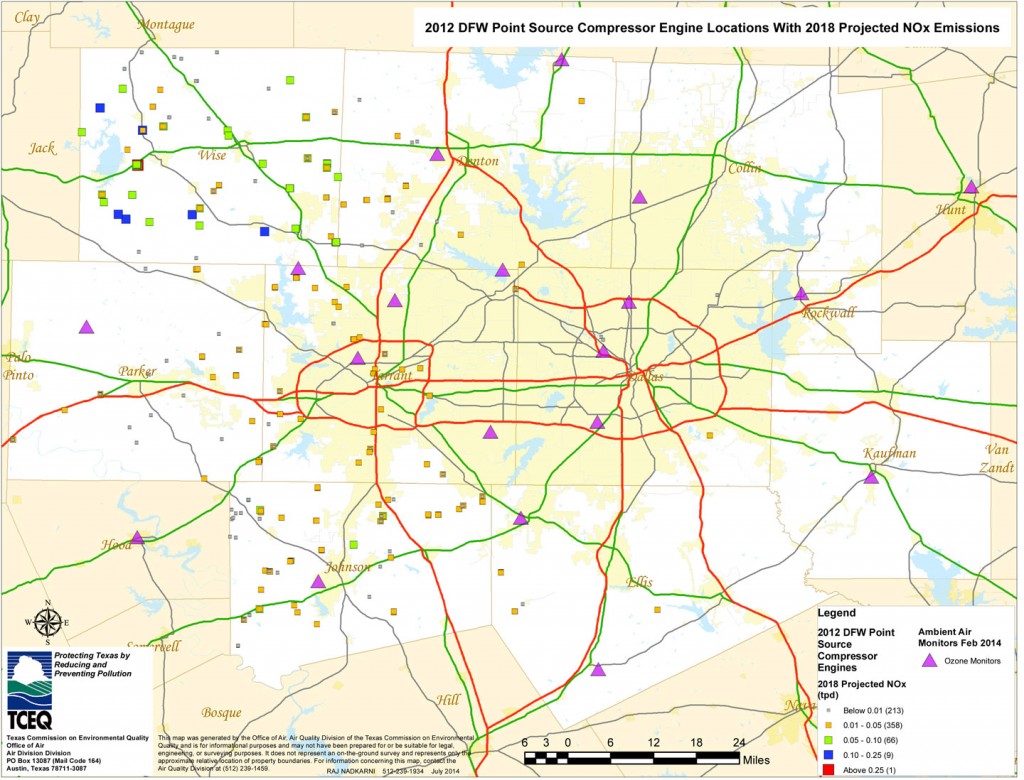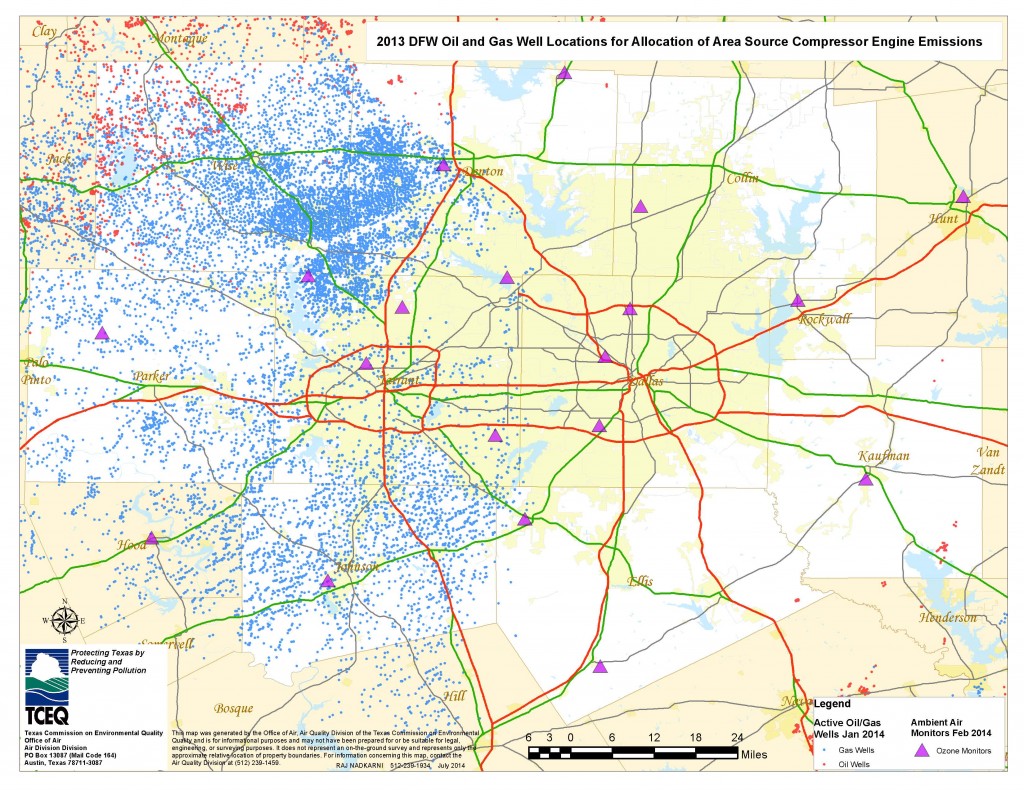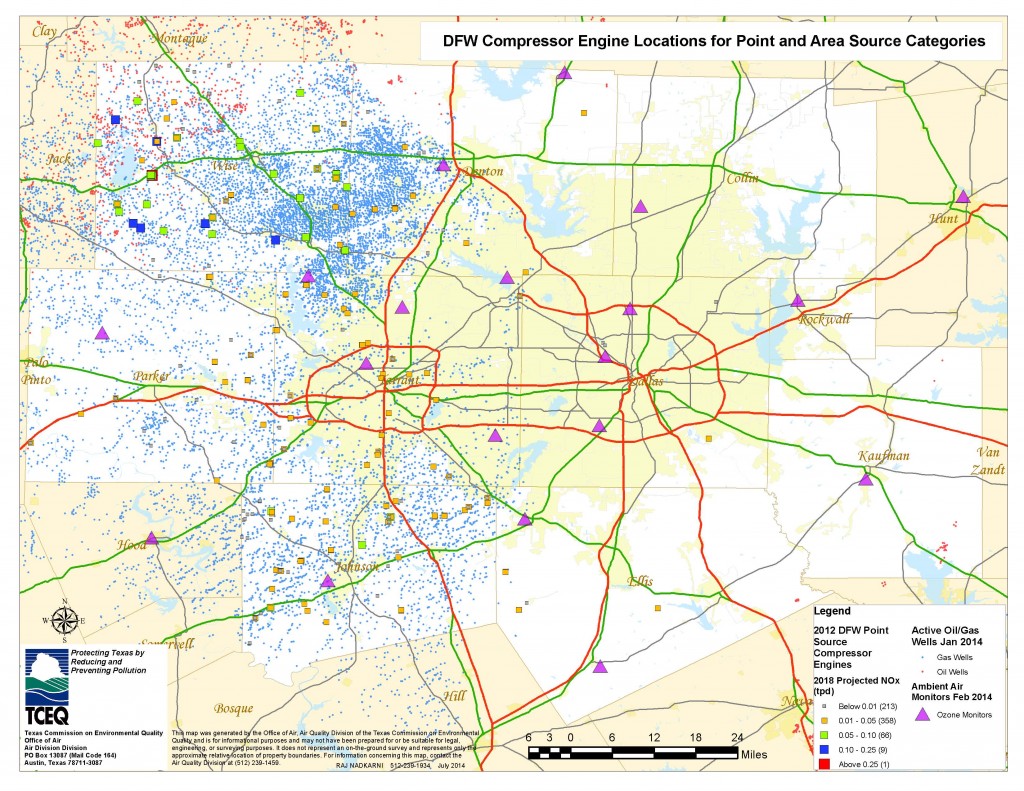Posts Tagged ‘Fracking Pollution’
Maryland: Toxic Air Pollution Top Threat From Fracking
 According to a state-sponsored study through the University of Maryland's School of Public Health, "air emissions trump water pollution and drilling-induced earthquakes as a top public health threat posed by future fracking projects in Maryland."
According to a state-sponsored study through the University of Maryland's School of Public Health, "air emissions trump water pollution and drilling-induced earthquakes as a top public health threat posed by future fracking projects in Maryland."
For the better part of a year, faculty surveyed previous research between the gas industry and health effects. They looked at all the possible "exposure pathways" for toxins to reach surrounding populations from gas rigs and facilities and ranked each of the threats. Air quality got a "high" threat ranking, whereas water pollution ranked "moderately high" threat and earthquakes "low."
Dr. Donald Milton, Director of the Maryland Institute for Applied Environmental Health and a UMD professor of epidemiology, biostatistics, and medicine was the study's lead investigator and concluded,
"….existing data show a clear trend: oil and gas activity can spew significant levels of toxic chemicals into the air—and that pollution consistently makes people sick.
"We think [the state] should pay a lot of attention to air pollution," said Milton. Although water pollution is also a concern, Milton told InsideClimate News that there's not enough data on how likely dirty water is to sicken people, nor how strong those health effects would be."
Because most of the reviewed data in the study comes from gas plays that have received a lot of attention over the last couple of years – the Barnett and Eagle Ford in Texas, the Marcellus in Pennsylvania, and the Bakken in North Dakota – Maryland's environmental and public health officials were quick to offer a joint damning disclaimer: "We believe it is important to note that it is largely based on information on natural gas development in areas where the pace of gas development was rapid and intense and without stringent regulations and government oversight." Well yeah, but if our own officials weren't so negligent you wouldn't have the benefit of now learning from our bad examples.
The study was part of a 2011 executive order signed by Maryland Governor Martin O'Malley that outlined a state approach to dealing with potential fracking in the state's western corner, where the Marcellus extends across the Pennsylvania line.
Besides identifying air pollution exposure as a major threat, the study also offered specific recommendations to combat that exposure, including:
– a 2000-foot setback from urban neighborhoods (Dallas and Southlake both have 1500-foot setback provisions)
– baseline air quality monitoring before any drilling or production begins
– constant air monitoring when activity on the site begins
– transparency in the information about the facility.
As the Inside Climate article on the study notes, its conclusions "stand in stark contrast to public concern in heavy-drilling states such as Maryland's neighbor Pennsylvania. Those concerns have tended to focus on tainted water, not air."
Indeed. It's a lot easier to make a fire-breathing water hose into a drive-by YouTube meme than a family gasping for air that won't make them sick. But for most neighbors of urban gas drilling, water quality isn't even on the radar screen because they're getting their H2O from a city pipe running from a lake, not a well. On the other hand, they're directly breathing in the mix of chemicals and pollution coming off the site itself, making their home a frontline toxic hot spot. That site's plume is then combining with hundreds or even thousands of other plumes from similar sites close-by to decrease regional air quality. That air pollution can end-up affecting thousands or millions of residents who don't even live in close proximity to a rig or compressor.
In the most successful "nuisance" court cases against gas operators in the Barnett Shale over the last year or so, air pollution has been the villain keeping families from enjoying their property and running up their medical bills. You can get water trucked in, but it's very hard to do the same with air.
Public comment on the report is open until October 3rd.
Three Easy Pictures: Why the TCEQ Didn’t Want Compressor Locations Publicized


 These are maps that supposedly weren't available…until they were.
These are maps that supposedly weren't available…until they were.
From January all the way through June, citizens involved in watch-dogging the state's drafting of an anti-smog plan for North Texas had been asking if the Texas Commission on Environmental Quality had maps of the locations of all the gas compressors in the 10-county DFW "non-attainment" area for ozone.
The answer from the state, over the course of at least three regional air quality meetings in Arlington, was always no.
Then State Representative Lon Burnam asked the same question, officially, in a letter to TCEQ. About two weeks ago, he got these three maps in the mail. Thanks to Representative Burnam for his follow-though.
This dodge followed an attempt by the state to hide the emissions from these compressors in other categories besides "Oil and Gas" in an attempt to minimize the industry's air pollution impacts on DFW air quality.
You can understand why TCEQ wasn't eager to show these maps.
The first shows the location of 647 large gas compressors. The volume of air pollution from each of these compressors is so large that they're considered "point sources" like power plants, cement plants, manufacturing plants, etc. According to the TCEQ, these larger compressors will be emitting over 14 tons of smog-forming Nitrogen Oxide pollution PER DAY by 2018.
The second shows the approximate location of the thousands of smaller, "area sources" compressors. TCEQ doesn't really know how many of these there actually are – they've never counted and no inventory by industry is required.
Instead, the state bases the number and approximate location of these smaller compressors on the production rates of gas in the Barnett Shale, as reported by the Railroad Commission, and disperses them accordingly.
There's some question about whether this is the most accurate way to take a count – a lot of industry literature says you should use the number of wells and the age of the wells instead of the production rate because as a gas field gets older, operators use more compressors to extract harder-to-get gas.
This is important because while production rates in the Barnett Shale have gone down, the number of wells is increasing.
The upshot is that as impressive as all those dots seem in the second map, they may actually represent an underestimate of the number of smaller compressors on the ground. As it is, TCEQ estimates these compressors will collectively release another six and a half tons of smog-forming Nitrogen Oxides PER DAY by 2018. That's in addition to the pollution of the larger point source compressors.
The last map is a combination of the first two. In all three the region's smog monitors are the purple triangles. Please take note of their location as well.
For over a decade now it's the monitors at the Denton Airport and in Northwest Tarrant County – at Meacham Field, in Keller, in Grapevine and Eagle Mountain Lake – that have recorded the highest smog readings in the entire regions.
There's no question as pollution accumulates over Dallas and Fort Worth and blows Northwest, ozone levels get higher. It's also true the pollution plumes from the Midlothian cement plants can blow directly into the paths of many of these monitors. But can anyone look at these maps and not realize that these gas compressors are also contributing to the high readings being recorded at the monitors in Denton and Northwest Tarrant County?
That's the real reason TCEQ didn't want the public to see these maps.
There's another regional air quality meeting next Tuesday, August 12th in Arlington from 10 am to 12 noon at the North Central Texas Council of Government offices at 616 Six Flags Road. These meetings are the only chance that citizens have to ask questions of TCEQ staff about the information going into drafting the new anti-smog plan. Without those kinds of questions, we still wouldn't know how much air pollution these gas compressors are emitting, or their location. Rep. Burnam would not know what official requests to submit. Information is power. Come get a little more empowered this next Tuesday.
The Biggest Fracking Fight That Isn’t Being Fought – DFW Air Plan Mtgs This Month
 Since fights over fracking began in the Barnett Shale, they've been mostly fights over specific permits, leases, or rules fought in one city at a time.
Since fights over fracking began in the Barnett Shale, they've been mostly fights over specific permits, leases, or rules fought in one city at a time.
Other than an occasional trip to Austin or DC to stop or support some piece of legislation, the action takes place in whatever community is putting up the most resistance. Front lines are fragmented and move around a lot. There's not a single cause that's united the energy from the multitude of ad hoc groups and individual "fracktivists" into a focused campaign for regional change. The closest thing to more encompassing battles have been the recent victories in Dallas and the current kickass campaign in Denton. These feel like old Cold War skirmishes – proxy clashes standing in for the on-going larger war over the Barnett Shale's soul.
But from now until the summer of 2015 there's a regional fracking fight waiting to be fought. It involves new bureaucracies and terms and mechanics, so it makes a lot of traditional fracking foes nervous. But the payoff is the potential to affect change throughout a 10-county area, including the heart of the urban Barnett Shale – Tarrant, Parker, Denton, Johnson, Wise and Ellis – as well as Dallas, Collin, Kaufman, and Rockwall.
What's the fight? It's over the new regional anti-smog plan, called a State Implementation Plan, or SIP. When a region hasn't met the federal standard for smog, also called ozone, it has to submit a plan to the EPA to explain how it's going to comply by the end of a three-year deadline. Despite at least three previous plans, DFW has never met the 1997 federal standard for smog. It's 85 ppb, or "parts per billion" concentration over 8 hours measured by approximately 20 stationary monitors scattered over the area. The closest we've come has been 86 ppb of ozone in 2009.
The new DFW plan is supposed to be designed to meet an even more ambitious target – no monitor higher than a three-year running average of 75 ppb of ambient air by 2018. We're at 87 ppb now. To reach the new goal, DFW would have to drop 12 parts per billion in ambient smog levels in four years -something that's never happened before.
Ozone/smog is created by a combination of Nitrogen Oxides (NOx) from combustion sources and Volatile Organic Compounds (VOCs) from combustion sources and evaporation sources mixing in daylight. The more sun, the more ozone.
What are combustion sources of NOx and VOCs? Power plants and cement kilns. Every boiler and furnace and oven. Every internal combustion engine. Every diesel engine. Anything with a flame or a spark.
What are evaporation sources of VOCs? Gasoline pumps,tanks and paint shops.
An anti-smog plan is supposed to look at all the sources of smog-forming pollution in a region and find the cheapest and easiest ways to reduce it. Past plans have been responsible for putting more controls on coal-fired power plants and the Midlothian cement plants, as well as creating HOV lanes and tightening inspection standards for vehicles. But one large category of smog-forming emissions has been left largely untouched by past air plans – the gas and oil industry.
It's not because gas and oil sources aren't capable of contributing to DFW smog. Start with all the trucks that are needed for each well and the NOx and VOC emissions they produce. Then the drilling rig itself. Some cities now require electric motors, others still allow diesel and the NOx and VOCs they produce. Think about all the chemicals being dumped into a well and then flowing back out, many of them VOCs. Flares are sources of both NOx and VOCs. Storage tanks and pipelines are huge sources of escaped evaporated VOCs. Diesel compressors are huge sources of NOx. There isn't a part of the oil and gas fuel cycle that doesn't produce smog-forming pollution.
It's not because the oil and gas emissions are insignificant. In 2011, the Texas Commission on Environmental Quality estimated that the VOCs being released by all the oil and gas facilities in the DFW area were greater than the volume of VOCs being released by all the cars and trucks on the road in the same region. In 2012, a Houston Area Research Council report estimated that a single flare or compressor could raise downwind ozone levels 3 to 5 parts per billion as far as five to ten miles away.
No, the oil and gas industry haven't been touched by these state anti-smog plans because the state doesn't want to impose new regional regulations on an industry. It's nothing personal. Austin doesn't want to impose new regulations on any industry. The last serious SIP was in 2007 – before the Barnett Shale boom and Rick Perry's presidential campaign. Since then, it's been one excuse after another from TCEQ about why no new controls are necessary – even though DFW air quality progress has stopped and we're still in violation of a 20-year old smog standard.
It's also true that the oil and gas industry hasn't been touched by an air plan because no one's made them. No DFW anti-smog plan has been the focus of a fracking campaign like the recent Dallas Trinity East permits, or the Denton petition drive. There been no pressure on state government to respond to a regional demand for action.
But the new DFW air plan does offer gas activists a chance to get reforms outside of their own city limits. For example, it could be the goal to include mandatory electrification of compressors in this plan. It's been estimated that 60 % or more of the air pollution from the gas fuel cycle comes from compressors. Electrification doesn't solve all their air pollution problems but it takes a huge bite out of them because the compressors are no longer being run by locomotive size diesel engines. Electrification of new compressors and a phase-in to replace existing diesel engines could reduce not just smog pollution, but toxic air pollution and greenhouse gases by thousands of tons a year.
Even if Austin rejects such proposals, there's a part of every plan called the "Weight of Evidence" category that's more inclusive to voluntary measures. A recommendation for cities and counties to demand electrification of all compressors in the DFW region isn't as immediate as a state-sponsored mandate, but it's an official good housekeeping seal you can take to local city councils and pass one by one until it does become a de facto regional policy. This is exactly what happened with Downwinders' Green Cement procurement campaign from 2007-2011 aimed at getting rid of old wet cement kilns in Midlothian. A short recommendation to local governments about where to buy their cement in the 2007 SIP was turned into a model ordinance by Dallas and then passed by a dozen other entities, one by one, over the next two years. by the end of this year, there will be no wet kilns lift in Midlothian.
The same thing could happen with compressors in this new plan, or green completions, or tanks, or pipelines in this new DFW air plan – if activists are willing to invest the same amount of time and energy into a regional fight as they do in their own backyard battles.
You have a couple of chances in April to dip your toes into the SIP Process. This coming Sunday, April 6th, from 3 to 5 pm at the Texas Campaign for the Environment office in Dallas, State Rep Lon Burnam and Downwinders at Risk will be hosting a strategy meeting for folks who want to know more about how to take advantage of this new air plan. Central to this strategy is involving more gas activists to win a regional fight, so y'all come.
Then on April 17th, at 10 am at the North Central Council of Governments Headquarters in Arlington, there's a meeting of the SIP "technical committee" that will be hearing presentations from the state and others about DFW's smog problem. Don't let the "technical committee" name fool you. These are open to the public and anyone can attend. In fact, this is your chance to ask questions of the state and the experts.
And to make it more interesting, we think we've managed to convince the Powers That Be to include UNT graduate student Mahdi Ahmadi's presentation on Barnett Shale contributions to DFW ozone as part of the April 17th meeting. This was the study recently featured by Peggy Heinkel-Wolfe in the Denton Record Chronicle:
According to the results, the air monitoring sites surrounded by oil and gas production activities, generally on the west side of DFW, show worse long-term trends in ozone reduction than those located farther from wells on the east side of DFW.
His spatial analysis of the data showed that ozone distribution has been disproportionally changed and appears linked to production activities, perhaps an explanation why residents on the western side of DFW are seeing more locally produced ozone, particularly since 2008.
If this one fails, another new air plan will not be due until at least 2019 or 2020 at the earliest. This is our only chance until then to affect the gas industry over a wide area instead of just one permit or one city at a time. Let's try to make it count.
DFW Anti-Smog Plan Strategy Meeting
Sunday April 6th 2-5 pm
Texas Campaign for the Environment Offices –
3303 Lee Parkway #402 • Dallas, TX 75219 – across from Lee Park
Hosted by St. Rep. Lon Burnam and Downwinders at Risk
DFW Air Plan Committee Meeting – open to the public
10 am to 12 noon
Thursday April 17th
North Central Texas Council of Governments
616 Six Flags Drive, Arlington – across the street from the amusement park
